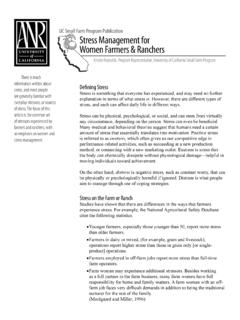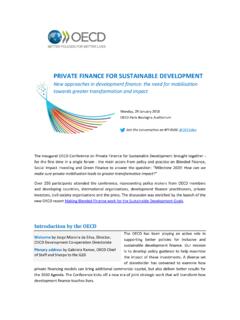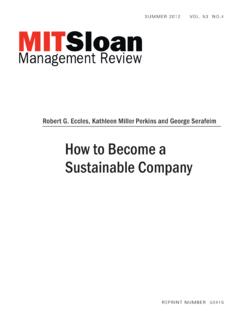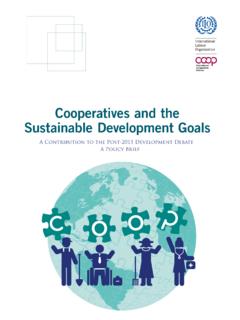Transcription of Urban Agriculture in Alameda County, CA: Characteristics ...
1 UC Small Farm Program Preliminary Research Findings Urban Agriculture in Alameda county , CA: Characteristics , Challenges and Opportunities for Assistance Kristin Reynolds, Program Representative, University of California Small Farm Program Introduction Urban and Urban -edge Agriculture involves growing food and fiber products in Urban areas, and extends to production inputs, processing, transport and marketing, in and around the edges of cities (van Veenhuizen 2006; Smit, Ratta, and Nasr 1996). Urban Agriculture includes both commercial and non-commercial operations.
2 In California, many agricultural operations fit this broad definition, though the nature of Urban and Urban edge operations may differ considerably. At the edges of cities and towns, formerly rural farmers and ranchers find themselves in closer proximity to Urban land uses. Within cities, residents and community organizations practice Urban farming and gardening for recreation, health and nutrition, community empowerment, and Urban greening (the planning and establishment of vegetative landscapes in Urban settings). Corn grows near power lines at a six-acre community garden in Hayward.
3 In recent years there has been renewed public interest in Urban Agriculture for its potential contribution to ecological health and community food security (CFS).1 This interest has grown alongside consumer enthusiasm about local food systems, which include the local aspects of food production, processing, distribution, consumption and waste management (UC SAREP ). Urban and Urban - edge farmers may have an advantage in certain respects ( , transportation costs) over operations located farther outside metropolitan areas. However they also face unique challenges.
4 Past studies have found that issues such as site contamination, governmental impediments, funding, and lack of community interest may limit development of Urban food production (Kaufman and Bailkey 2000; Feenstra, McGrew and Campbell 1999). Moreover, in Urban edge areas, new housing developments on what had been farmland bring with them potential conflict between farmers/ranchers and non-farming residents. Cooperative Extension programs may be of assistance in overcoming some of the challenges mentioned above, and some Cooperative Extension programs do work with aspects of Urban food production.
5 As examples, the Master Gardener Program trains a 1. This term and others are defined in the Terminology box on page 2. Terminology Urban Agriculture Food Justice Urban Agriculture is the growing of food and ber products The concept of food justice includes a consideration of the in and around Urban areas, including production inputs, social and economic inequities in a food system, emphasizing processing, transport and marketing (van Veenhuizen 2006; human rights, democracy, and local community control Smit, Ratta, and Nasr 1996).
6 (Levkoe 2006). Food System Food Desert A food system includes food production, processing, The term food desert describes an area where there are few distribution, consumption and waste management. The or no consumer food sources available. This situation often University of California Sustainable Agriculture Research and exists in poor Urban areas where unhealthy foods (such as Education Program also de nes a sustainable community potato chips or candy) may be available, but residents have food system as a collaborative food system network that limited access to healthy and affordable food (Hendrickson, integrates the above sectors in order to enhance the Smith, and Eikenberry 2006).
7 Environmental, economic and social health of a particular place. Culturally Acceptable Culturally acceptable, in the context of community food Community Food Security security, refers to foods that are both nutritionally and Community food security (CFS) refers to the ability of all symbolically important to a given ethnic and/or regional persons obtaining, at all times, a culturally acceptable, culture. While many varieties of foods are available in today's nutritionally adequate diet through local, non-emergency marketplace, certain products are not readily available in sources (Gottlieb and Fisher 1996).
8 All areas or to all people. Thus, the reference to cultural acceptability within the de nition of CFS is explicit. Social Justice A broad concept in social theory, social justice is applied Urban Homestead here in the context of a food system. It refers to a variety of An Urban homestead is a household that produces a significant social equity and human rights issues ranging from farmworker part of the food, including produce and livestock, consumed wages to food access for those on limited incomes (Feenstra by its residents.)
9 This is typically associated with residents'. 2002; Allen et al. 2003). desire to live in a more environmentally conscious manner. corps of volunteers to assist home gardeners; the 4-H an Urban county ; to identify challenges experienced Program provides youth with diverse opportunities by Urban area producers; and to explore potential including raising small livestock and landscape design; areas of information and assistance that Cooperative and the UC Small Farm Program works to extend Extension might provide in order to enhance both research-based technical advice to small farmers, the sustainability of Urban agricultural operations and many of whom farm at the Urban edge.
10 Each of these Urban community food security. The research consisted programs is effective in delivering information to its of interviews with practitioners and consultations with respective clientele, regardless of their locale. There supporting organizations. The findings presented here may also be need for additional Cooperative Extension are preliminary. More in-depth analytical findings will programming that is developed to address challenges be published as part of the author's doctoral dissertation experienced specifically by producers located in Urban and made available at a later date.










